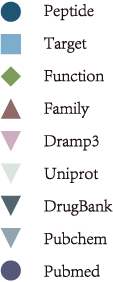Beta-Amanitin
Basic information
| CPKB ID | CP00003 |
| IUPAC Name | 2-[34-butan-2-yl-13-(3,4-dihydroxybutan-2-yl)-8,22-dihydroxy-2,5,11,14,27,30,33,36,39-nonaoxo-27lambda4-thia-3,6,12,15,25,29,32,35,38-nonazapentacyclo[14.12.11.06,10.018,26.019,24]nonatriaconta-18(26),19(24),20,22-tetraen-4-yl]acetic acid |
| Synonyms |
|
| Source |
Amanita phalloides [Division : Plants and Fungi]
Taxonomy :67723 (Fungi-Basidiomycota-Agaricales-Agaricomycetes-Amanitaceae Amanita) Wikipedia: Amanita phalloides Conocybe [Division : Plants and Fungi]
Taxonomy :71669 (Fungi-Basidiomycota-Agaricales-Agaricomycetes-Bolbitiaceae Unassigned) Wikipedia: Conocybe Galerina [Division : Plants and Fungi]
Taxonomy :109632 (Fungi-Basidiomycota-Agaricales-Agaricomycetes-Strophariaceae Unassigned) Wikipedia: Galerina Lepiota [Division : Plants and Fungi]
Taxonomy :37314 (Fungi-Basidiomycota-Agaricales-Agaricomycetes-Agaricaceae Unassigned) Wikipedia: Lepiota PubChem |
| Family | |
| Function | |
| Information |
Beta-Amanitin is one of a group of at least eight Amatoxins found in several genera of poisonous mushrooms, most notably Amanita phalloides and several other members of the genus Amanita, as well as some Conocybe, Galerina and Lepiota mushroom species. (L1774) |
Legend

Structure
| Molecular Formula |
C39H53N9O15S |
| Molecular Weight | 919.338183 g/mol |
| SMILES | CCC(C)C1NC(=O)CNC(=O)C2Cc3c([nH]c4cc(O)ccc34)S(=O)CC(NC(=O)CNC1=O)C(=O)NC(CC(=O)O)C(=O)N1CC(O)CC1C(=O)NC(C(C)C(O)CO)C(=O)N2 |
| InChI | InChI=1S/C39H53N9O15S/c1-4-16(2)31-36(60)41-11-28(53)42-25-15-64(63)38-21(20-6-5-18(50)7-22(20)45-38)9-23(33(57)40-12-29(54)46-31)43-37(61)32(17(3)27(52)14-49)47-35(59)26-8-19(51)13-48(26)39(62)24(10-30(55)56)44-34(25)58/h5-7,16-17,19,23-27,31-32,45,49-52H,4,8-15H2,1-3H3,(H,40,57)(H,41,60)(H,42,53)(H,43,61)(H,44,58)(H,46,54)(H,47,59)(H,55,56) |
| InChIKey | IEQCUEXVAPAFMQ-RDTCRXGGNA-N |
|
2D Structure
PubChem|2276
|
|
|---|
Sequence
| One letter code from Structure | CDPIWGIG |
| Amino acid chain from Structure | Ile(1)--Gly--Cys(2)--Asp--4OH-Pro--Ile--Trp(2)--Gly(1) |
| Description of the conversion sequence | The one letter code and Amino acid chain derived from the structural transformation may be inconsistent, with the Amino acid chain containing Essential Amino acid and the one letter code not. |
Structure Properties
| Property Name | Property Value | |
|---|---|---|
| Exact Mass | 919.338183 | |
| Number of Rings | 5.0 | |
| Complexity | 0.859375 | |
| XlogP3 AA | -5.3209 | |
| Heavy Atom Count | 64.0 | |
| Hydrogen Bond Donor Count | 13.0 | |
| Hydrogen Bond Acceptor Count | 14.0 | |
| Rotatable Bond Count | 7.0 |
| Property Name | Property Value | |
|---|---|---|
| Formal Charge | 0.0 | |
| Refractivity | 220.705 | |
| Rule_of_Five | 0.0 | |
| Number of Atoms | 64.0 | |
| Topological Polar Surface Area | 375.09 | |
| Refractivity | 220.705 | |
| Veber Rule | 0.0 | |
| Ghose Filter | 0.0 |
| Property Name | Property Value | |
|---|---|---|
| RDKit Fingerprint |
11101111111110101111110011111011111111110111011010111011101011001110101111111110111111101110110011110111111111111010111111110111111001111111111111011111000110011101101010111111110111011111111110110110111101101000100110011000010101000111111111101110111111111111001111111111110111101111111110101011111011010111111111010001110111101111111111011110111101110111111101111101001111000011111100101010011101011111100110101110100110111101101000111011111111110110011110111111111011011001100001001110001111011111100101101111111100111110110011111101000110000101111111010111111101101110010111101101010110111100111110110001101110111010101010111001110100111100110111110111111111111110111110111111010111011101111101111000111111100000100111110111111101111111111010111011111110111011111110111000101111111011111110011111001111111111100001101101111011111100111011111101111101110111011100111111101110100101111010010011100101001110111111111110111110011111110001011110101000011110111101111010011101011111101011110101111101011010010011111001111111110111110110111111111011101011010111111010101101100111110111001101110111111101101101111111110011101010110110101101010110010111101001011000111110111110100111101111011111011111101011000111110001101111111111100111111111110111011111111011101111010110101111101110110001111111110101111001011111111101101111101101100101111011111111110101110110111111111011110101111101011111011101100011110001011110111111100101101111101101010011111111101101011011111110101110111101111101110101111111011011000111100100110111111001101101011011011110111111110101011111111001111101100111111111111111100110000011100111111111011110100111111111111110101100011110010011011111100011100111111011100101010000111100111111110100100111010111010111011000100111111111011011111101111111010111100010111110100011111011101101111111111111111101101111110011111110111111111011111111101111111010111111101111010100001111111110111110101101100101011001110111101110111111110110110111011011111111111111011111101111100111111111111000111111011110101111101110010110100100111011110011 |
|
| Morgan Fingerprint |
0100011000100000000100000000110011000000001000000000000000000000010000000000000010000000001000000000000000000100000100010000000000100000000000000000000000000000000000000000000000000000000000000010000000000000000000000000001000010001010000000000000000000010000000000000100000000000000100001100001000100100000000000010100000000000000001000000000000000000000010000100000000000000000001000000010000000000000000000000000010000000000000000000000010000000000000000000000000000000000000000010000000001000100000010000100000000001100000000000000000000000000000010000000000000000000000000011000000000011000010000000000100001000010000000100000000000000000000000010001000000000010001000000000000001000000000000000000010000100010100000110001000000000000100000100000000000000000000000000000000000000000000000000000000000001000000000000000000000001000000001010000101000100000010000001000000010000000000001100010100000000000000000000000000000010000000011000000000000000001000000000000000000000011000000000000000000011000010000000000000010000 |
|
| MACCS Keys |
00000000000000000000000000000000000010000000000100010110000111000101000011000001011101001011100111001110110001110111110011111101110110001111111110101111111111111111110 |
Sequence Properties
| Property Name | Property Value | |
|---|---|---|
| Boman Index | -0.826249999999999 | |
| Instability | 9.25 | |
| Charge | -1.0635439323776 | |
| Aliphatic Index | 97.5 |
Biologic Description
Toxicity PubChem|2276
The major toxic mechanism of amatoxins is the inhibition of RNA polymerase II, a vital enzyme in the synthesis of messenger RNA (mRNA), microRNA, and small nuclear RNA (snRNA). Without mRNA, essential protein synthesis, and hence cell metabolism, grind to a halt and the cell dies. (L1774)
Metabolism PubChem|2276
Free toxin may be removed by opsonization via the reticuloendothelial system (primarily the liver and kidneys) or it may be degraded through cellular internalization via the lysosomes. Lysosomes are membrane-enclosed organelles that contain an array of digestive enzymes, including several proteases.
Manufacturers
| Manufacturers Name | Value | |
|---|---|---|
| CreativePeptides | ||
| Bayer healthcare pharmaceuticals | ||
| Upsher smith laboratories | ||
| Merck |
| Manufacturers Name | Value | |
|---|---|---|
| Apotex | ||
| Baxter Healthcare Corp | ||
| Pharmasources | ||
| Novartis | ||
| AstraZeneca |
Forecasting tools
| Forecasting tools | Value | |
|---|---|---|
| Structure to Sequence | ||
| Structure Properties | ||
| Sequence to Structure | ||
| Sequence Properties | ||
| Expasy ProtParam Tool | CDPIWGIG | |
| SEA | RUN SEA Predictions |
Information Source
| Property Name | Property ID | |
|---|---|---|
| Patents | IEQCUEXVAPAFMQ-RDTCRXGGNA-N | |
| pubchem | 2276 | |
| Drugbank | ||
| DRAMP3 | ||
| Uniprot | ||
| Cybase | ||
| CONOSERVER | ||
| BindingDB | ||
| CHEMBL | CHEMBL1978871 | |
| CTD | ||
| Wikipedia | %CE%92-Amanitin | |
| KEGG Compound/Drug | ||
| CHEBI | IEQCUEXVAPAFMQ-RDTCRXGGNA-N | |
| EPA DSSTox | ||
| FDA Global Substance Registration System (GSRS) | ||
| DTP/NCI | ||
| Chemspider | IEQCUEXVAPAFMQ-RDTCRXGGNA-N |
Reference
| Pubmed_ID | Title | DOI | Journal | |
|---|---|---|---|---|
2087697 |
10.1016/0041-0101(90)90102-d. | Toxicon |
||
Cytotoxicity on L1210 leukemic cells of beta-amanitin-concanavalin A and phallacidin-concanavalin A conjugatesAbstract
|
||||
2397216 |
10.1021/bi00481a012. | Biochemistry |
||
Epidermal growth factor labeled beta-amanitin-poly-L-ornithine: preparation and evidence for specific cytotoxicityAbstract
|
||||
3124301 |
10.1016/0041-0101(87)90161-9. | Toxicon |
||
Preparation of a beta-amanitin-concanavalin A conjugate of low toxicityAbstract
|
||||
